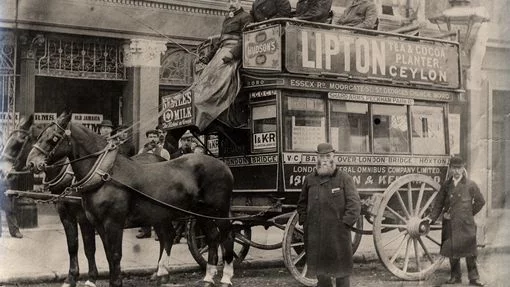
On the Surface 1900-1945
Introduction to the gallery
In 1900, almost every vehicle on London’s streets was horse-drawn. More than 300,000 horses were needed to keep the city on the move, hauling everything from private carriages and cabs to buses, trams and delivery vans.
Early mechanical vehicles were unreliable and short-lived. Electric tramways had been running in a number of American and European cities since the 1880s, but London did not have an electric tram line until 1901 when the first service opened between Shepherds Bush and Kew.
By 1914, trams were running throughout London, carrying 800 million passengers annually. While horses continued to be used for most deliveries, horse buses and horse trams had disappeared in London, and motor taxis heavily outnumbered horse-drawn cabs.
Motor bus design advanced quickly after the debut of the B type in 1910. Covered top decks and pneumatic tyres made buses more comfortable in the 1920s, and many new routes were introduced to link up London’s new suburbs and Underground lines.
In 1935, electric trolleybuses, powered using the same overhead lines as trams, began to replace trams, and Londoners were making 1,958 million bus journeys annually, twice as many as in 1921
Must-see objects
Read more...
During Queen Victoria's reign (1837-1901), London's population grew at an astonishing rate. London’s centre became increasingly congested. Read more about public transport in Victorian London – on the surface.
At the start of the nineteenth century there were no buses or railways in London. The city was compact, and its narrow streets crowded. Learn how George Shillibeer, a coachbuilder and stable keeper and the London General Omnibus Company shaped London’s horse bus era.
Although the first motor bus operated in 1899, early experimental vehicles were not practical or reliable. Learn how sturdier buses began to emerge and how London’s biggest bus companies operated them.
More from the Museum guide
How did London Transport first form? Find out how and why Lord Ashfield merged all of London's transport operators in the early 1900s.
London by Design celebrates London’s transport design heritage, including the iconic roundel, map, font, posters and more.
Through both the First and Second World Wars, London’s transport system and its staff played a vital role in keeping the city moving and contributed to the wider war effort.










